The Shape of Water
Spent about half the day on Sunday digging out from the most recent snowstorm, armed with snow shovels, ice blowers, salt and gravel. So, I had a lot of time to think about snow, ice and water in its various forms.
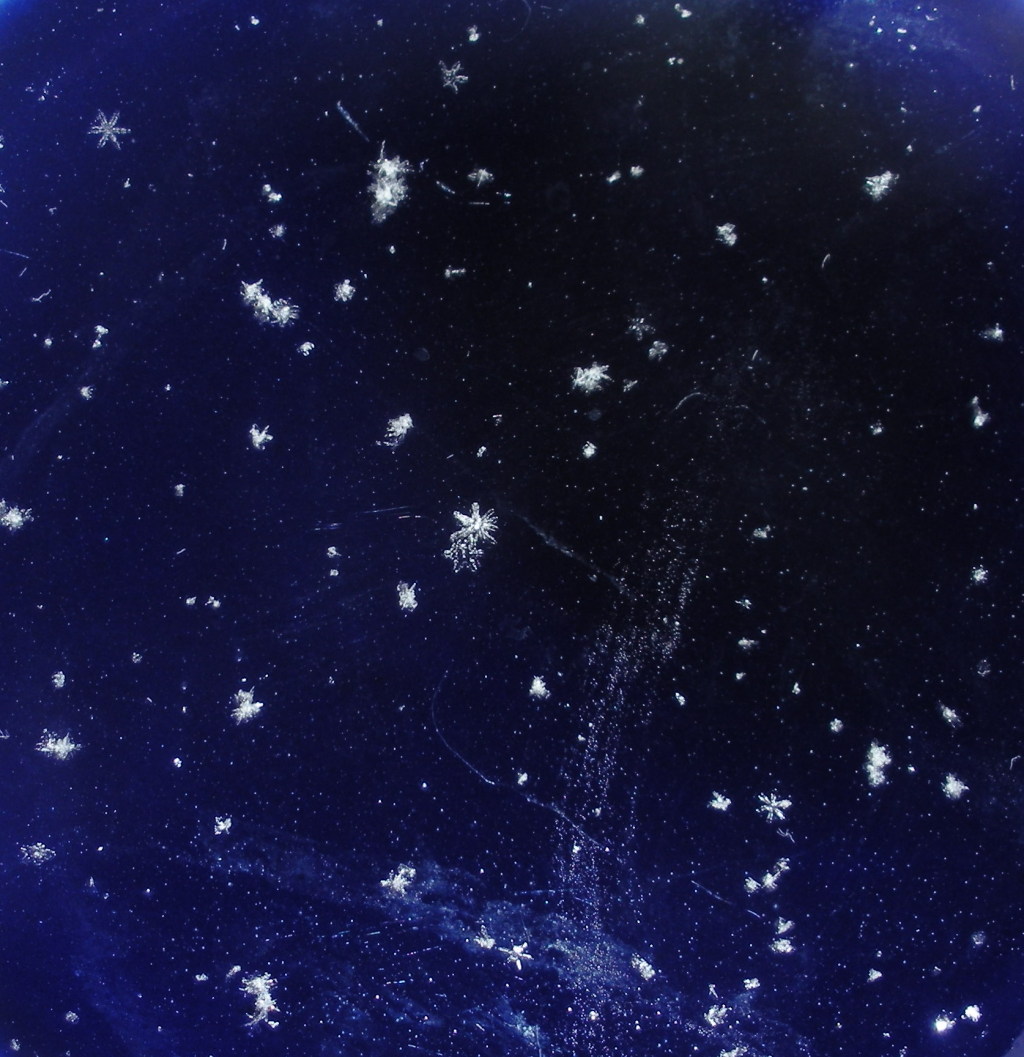 It took a while for the ingredients of water to appear on the scene in this floating world. The protons that go into making the “core” of Hydrogen appeared first, about a millionth of a second after the start of the Big Bang, when the soup of quarks had cooled enough to congeal into protons (don’t you hate it when your quark soup does that?). It took another four hundred thousand years for the protons to combine with electrons, which orbit around them to form the tiny little solar system we call a Hydrogen atom.
It took a while for the ingredients of water to appear on the scene in this floating world. The protons that go into making the “core” of Hydrogen appeared first, about a millionth of a second after the start of the Big Bang, when the soup of quarks had cooled enough to congeal into protons (don’t you hate it when your quark soup does that?). It took another four hundred thousand years for the protons to combine with electrons, which orbit around them to form the tiny little solar system we call a Hydrogen atom.
The other ingredient in water, Oxygen, was a lot more tricky. You have to pack eight protons together closely to make the core of Oxygen, and protons hate to get close to each other (I think Bohr called it the “proton cootie” effect). The universe had to cool down enough for all the light elements to condense into stars, dense enough that the protons were crushed together in nuclear fusion, causing the stars to light up as they formed heavier elements such as Oxygen. Altogether, that whole process took another couple million years.
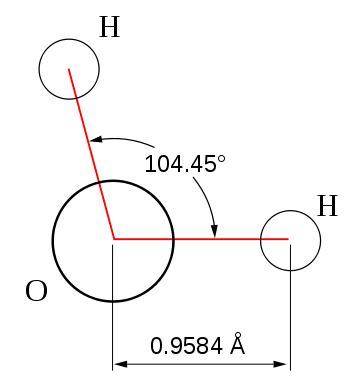 From there, the recipe for making water is fairly simple: combine two Hydrogen atoms with an atom of Oxygen and light a match. After your singed eyebrows grow back you will have a molecule of water, H20.
From there, the recipe for making water is fairly simple: combine two Hydrogen atoms with an atom of Oxygen and light a match. After your singed eyebrows grow back you will have a molecule of water, H20.
At room temperature on earth, water is liquid, but once it gets cold enough, it becomes solid and forms ice. Depending on how cold it is, how humid, and what the air pressure is, the ice will take on different shapes. There are sixteen known kinds of ice, but most are very rare around here, and only appear in odd places such as Mars or one of Saturn’s moons. 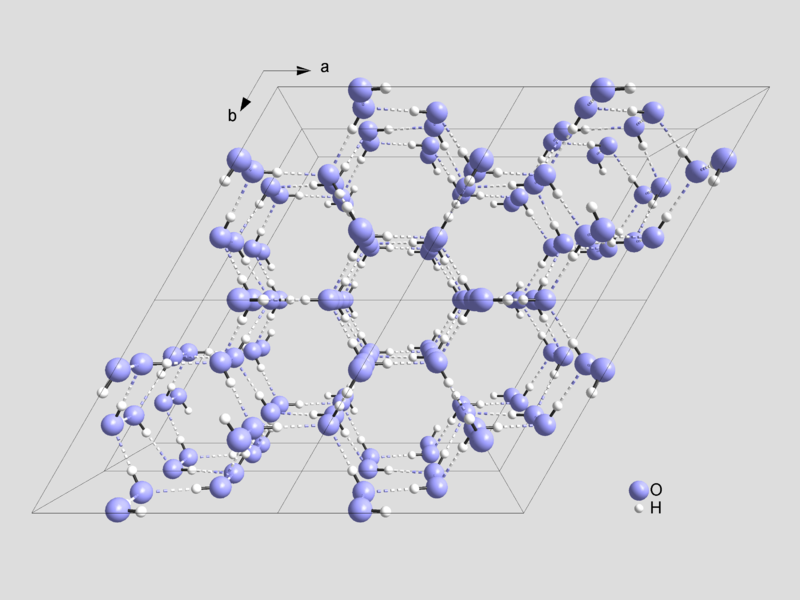 The most common ice on earth is called hexagonal Ice One, so called because the water molecules all line up in a nice six-sided honeycomb shaped array. I had always assumed that this was old knowledge, but was surprised to learn that the structure of common ice was not understood until Linus Pauling (famous for promoting Vitamin C, and almost beating Watson & Crick to the discovery of the DNA double helix) figured out its shape back in 1935. He had to use the brand new theory of quantum mechanics to do it, so I guess ice is a lot more tricky stuff than I thought.
The most common ice on earth is called hexagonal Ice One, so called because the water molecules all line up in a nice six-sided honeycomb shaped array. I had always assumed that this was old knowledge, but was surprised to learn that the structure of common ice was not understood until Linus Pauling (famous for promoting Vitamin C, and almost beating Watson & Crick to the discovery of the DNA double helix) figured out its shape back in 1935. He had to use the brand new theory of quantum mechanics to do it, so I guess ice is a lot more tricky stuff than I thought.
(Incidentally, fans of Kurt Vonnegut Jr.’s book Cats Cradle will be interested to learn that there really is an Ice Nine. When he wrote the book there were only seven known. Fortunately for us, the real Ice IX does not have a freezing point above room temperature. So it goes.)
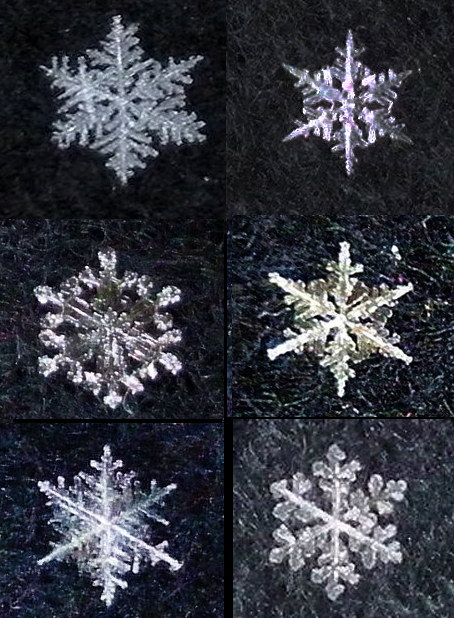 Anyway, it’s from those six-sided hexagons in the ice crystals that snowflakes get their pretty, unique shape, such as the ones that I was able to capture in the photos here at left. The general way that snowflakes form is understood, but there are some things about the perfect symmetry of many snowflakes that scientists still cannot completely explain. The main character in my novel won a prize (in the story) for his solution to the question of why snowflakes are so symmetrical… but you’ll have to read the book to find out what that is.
Anyway, it’s from those six-sided hexagons in the ice crystals that snowflakes get their pretty, unique shape, such as the ones that I was able to capture in the photos here at left. The general way that snowflakes form is understood, but there are some things about the perfect symmetry of many snowflakes that scientists still cannot completely explain. The main character in my novel won a prize (in the story) for his solution to the question of why snowflakes are so symmetrical… but you’ll have to read the book to find out what that is.
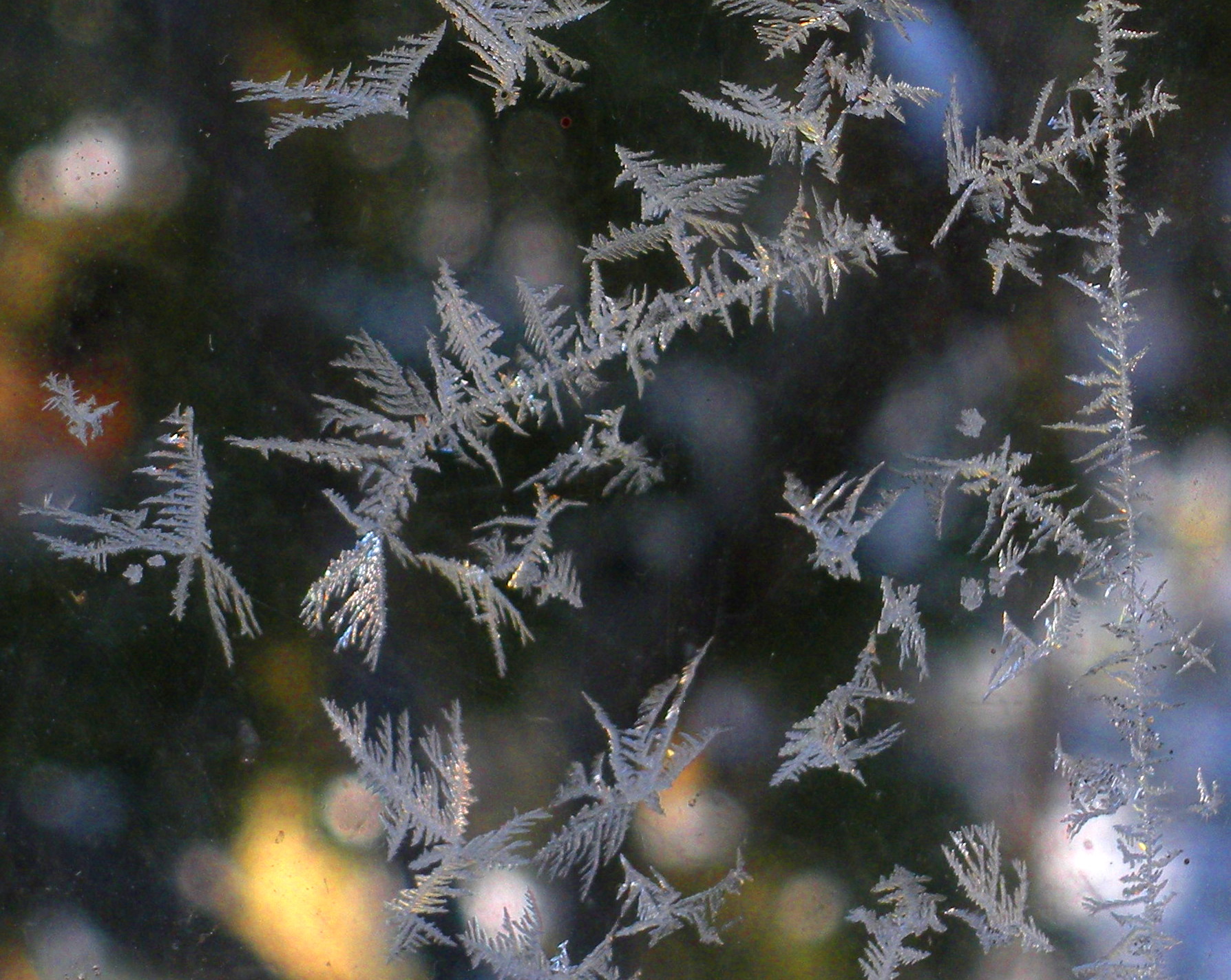 Even if the ice crystals are not free-floating but stuck on something, the same processes that make snowflakes form the fern-like branches of frost on our bedroom window.
Even if the ice crystals are not free-floating but stuck on something, the same processes that make snowflakes form the fern-like branches of frost on our bedroom window.
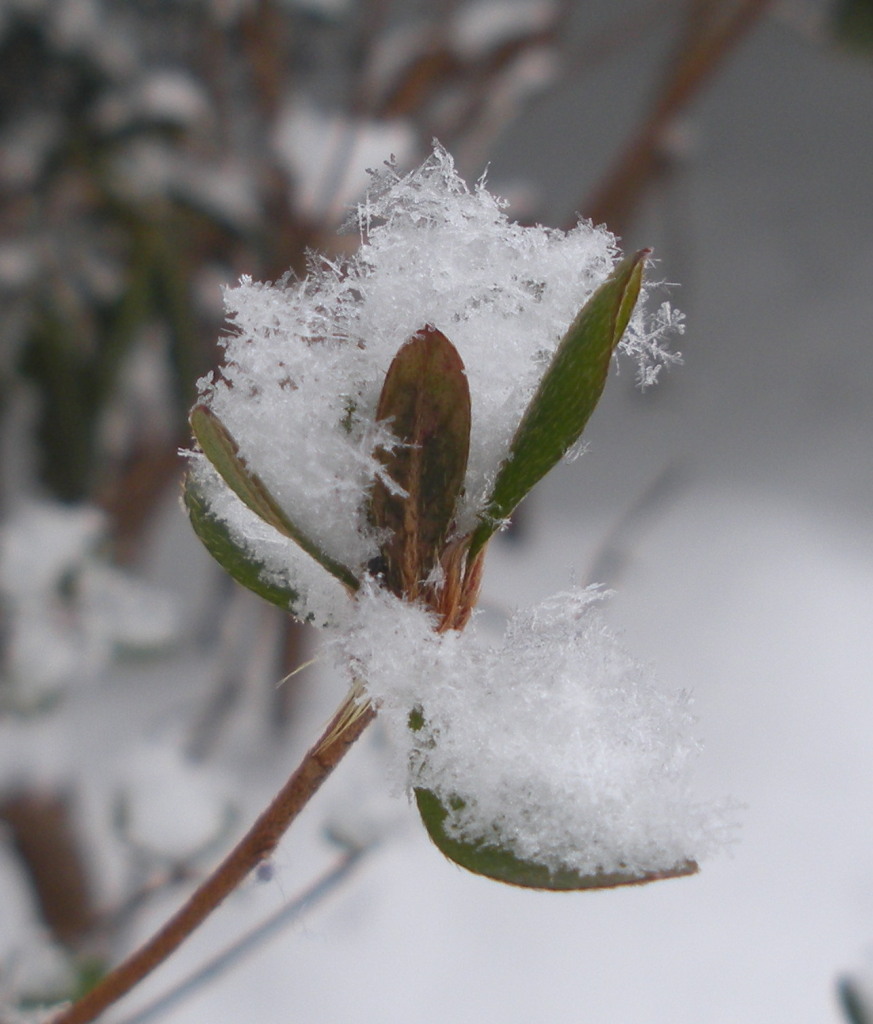 The ice crystals in snow act like little prisms that reflect and scatter all the the light that goes through them, so that if enough of the stuff piles up on the ground, the only color you see is — white. On a clear day the shadows of the snow appear blue, because they are reflecting the only light that hits them directly, which is the blue of the sky.
The ice crystals in snow act like little prisms that reflect and scatter all the the light that goes through them, so that if enough of the stuff piles up on the ground, the only color you see is — white. On a clear day the shadows of the snow appear blue, because they are reflecting the only light that hits them directly, which is the blue of the sky.
 As you may recall, the first big snowstorm of the season hit us on the day before my birthday, December 20th. Over nine inches of snow fell altogether, and by the time we came out that morning the backyard and surrounding countryside was completely covered in what looked like smooth marshmallow creme…
As you may recall, the first big snowstorm of the season hit us on the day before my birthday, December 20th. Over nine inches of snow fell altogether, and by the time we came out that morning the backyard and surrounding countryside was completely covered in what looked like smooth marshmallow creme…
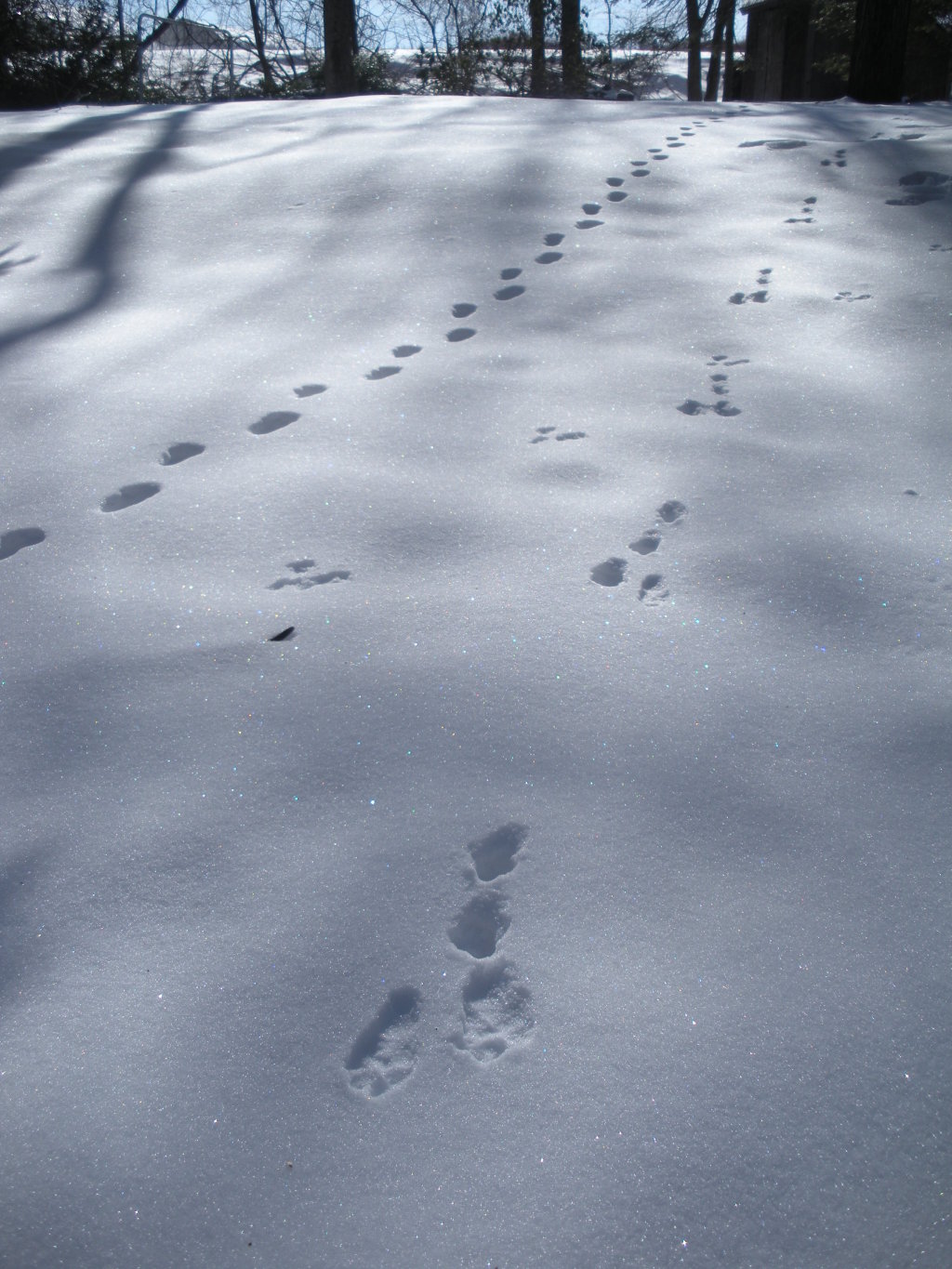 …except for the tracks. It was really interesting to play detective and try to sort out what animals had been wandering or hopping around our backyard the night before, where they came from and where they went. In this picture, to the far right the tracks of our “ten o’clock rabbit” can be seen. The rabbit is traveling towards the camera. The tracks of a rabbit hopping along at a modest clip is, I’ve learned, usually shaped in the form of the letter ‘Y’. The bottom of the Y is formed by the rabbit’s two front paws coming down for a landing, one in front of the other. The rabbit’s bigger hind legs then land slightly in front of the two prints, side-by-side.
…except for the tracks. It was really interesting to play detective and try to sort out what animals had been wandering or hopping around our backyard the night before, where they came from and where they went. In this picture, to the far right the tracks of our “ten o’clock rabbit” can be seen. The rabbit is traveling towards the camera. The tracks of a rabbit hopping along at a modest clip is, I’ve learned, usually shaped in the form of the letter ‘Y’. The bottom of the Y is formed by the rabbit’s two front paws coming down for a landing, one in front of the other. The rabbit’s bigger hind legs then land slightly in front of the two prints, side-by-side.
In the middle a squirrel was hopping away from the camera, crossing over the rabbit’s tracks. Squirrel tracks look like the letter ‘W’, because the squirrel puts his small front paws side-by-side, then his hind quarters land just past. To the far left a dog or a coyote was following along, possibly after the rabbit. We’ve seen more rabbit tracks since this photo was taken, so I’m pretty sure the ten o’clock rabbit is still on schedule and hasn’t been eaten.
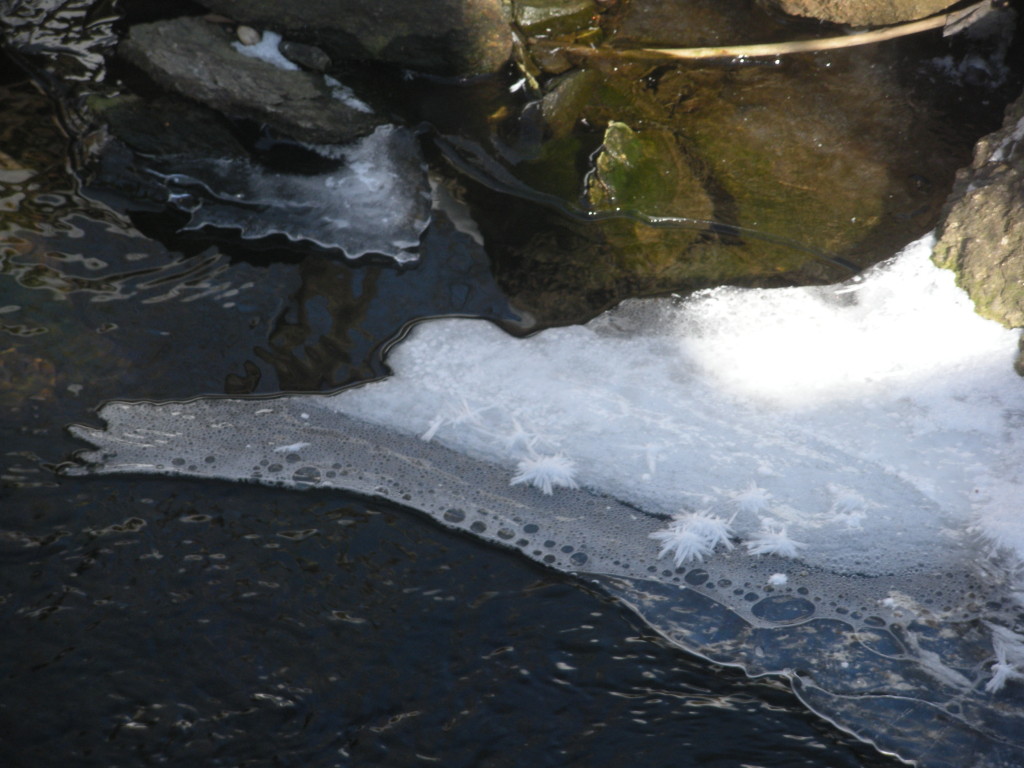 Eventually, as the temperature began to drop, the creek has started to freeze, forming plates out from the rocks and boulders in the water. A few snowflakes fell on the plates of ice, and they grew into these large white starfish crystals. They must have been a couple of inches wide.
Eventually, as the temperature began to drop, the creek has started to freeze, forming plates out from the rocks and boulders in the water. A few snowflakes fell on the plates of ice, and they grew into these large white starfish crystals. They must have been a couple of inches wide. 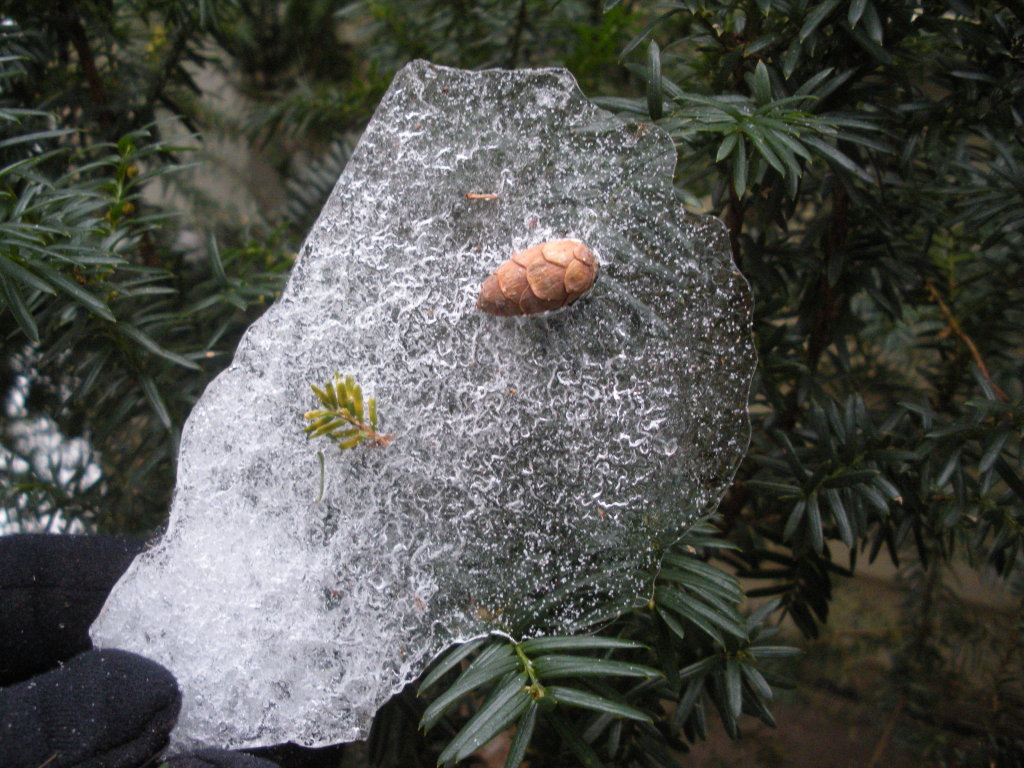 Some other plates of ice had formed in the front yard, capturing in the process some of the little spruce pine cones and needles. Gigi spotted this one sample.
Some other plates of ice had formed in the front yard, capturing in the process some of the little spruce pine cones and needles. Gigi spotted this one sample.
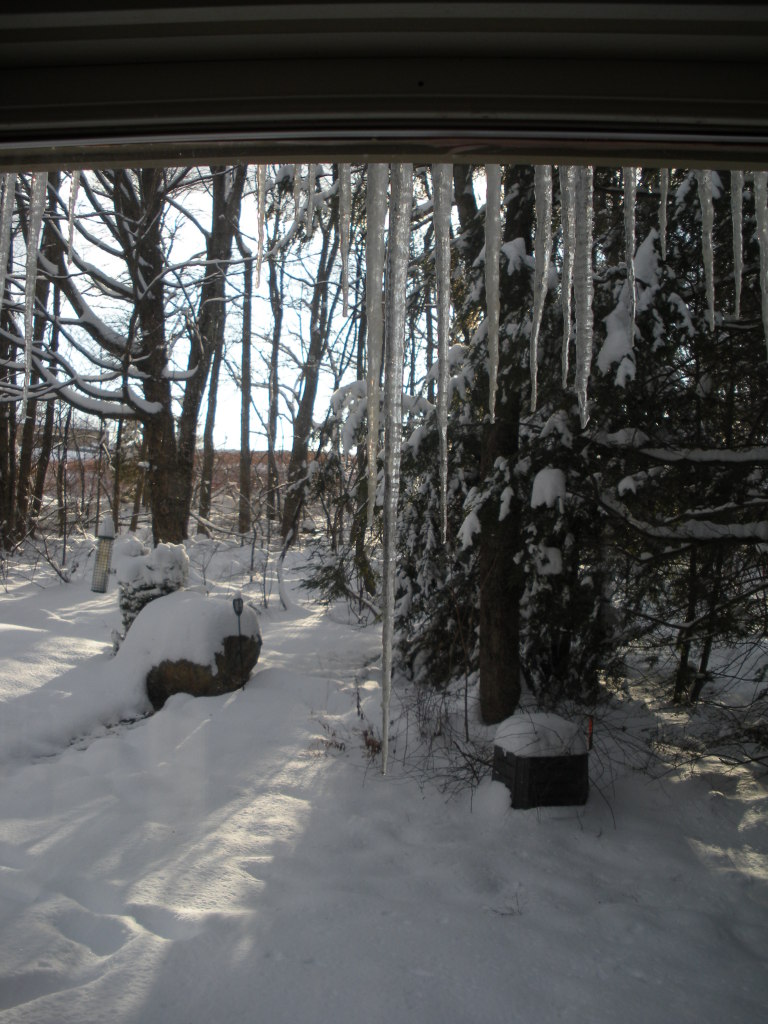 Some of the forms that water takes are no mystery. The icicles coming down from the roof, for example, just form when the snow on the roof, warmed by the inside air, melt and trickle down to the edge, freezing again in the cold night air.
Some of the forms that water takes are no mystery. The icicles coming down from the roof, for example, just form when the snow on the roof, warmed by the inside air, melt and trickle down to the edge, freezing again in the cold night air.
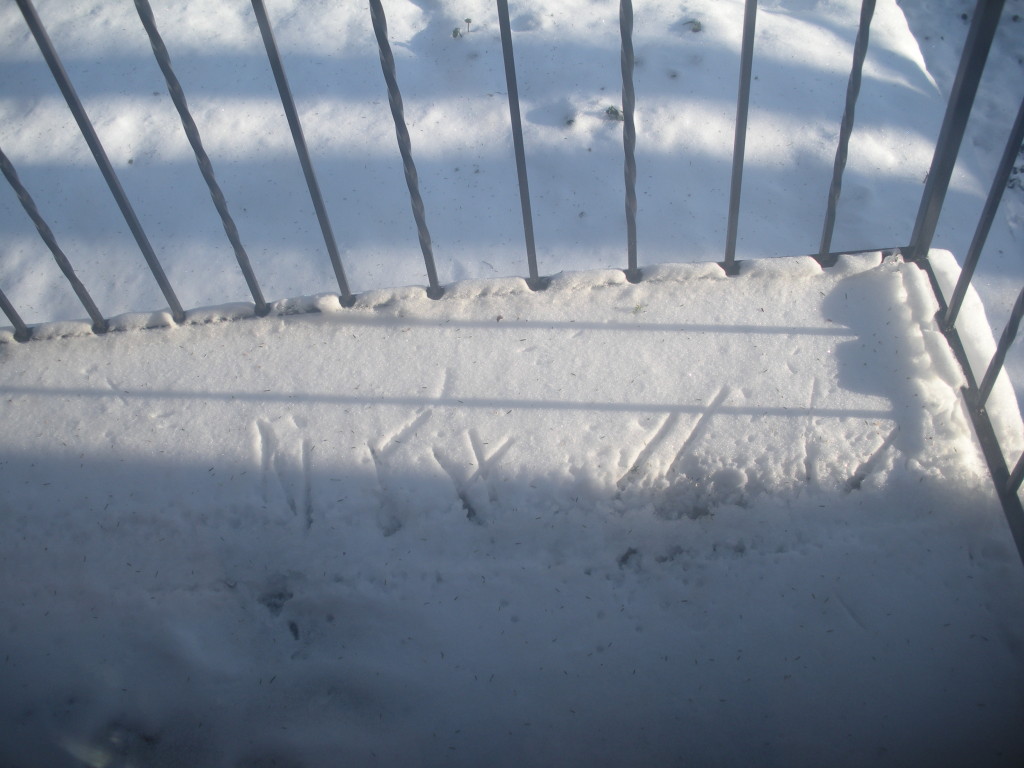 Some of these other features, however, took some guess work. I came down one morning to see what appeared to be roman numerals embedded in the snow. The mystery was resolved when I noticed that some of the icicles hanging from the roof had fallen into the snow at odd angles, carving out the figures you see here.
Some of these other features, however, took some guess work. I came down one morning to see what appeared to be roman numerals embedded in the snow. The mystery was resolved when I noticed that some of the icicles hanging from the roof had fallen into the snow at odd angles, carving out the figures you see here.
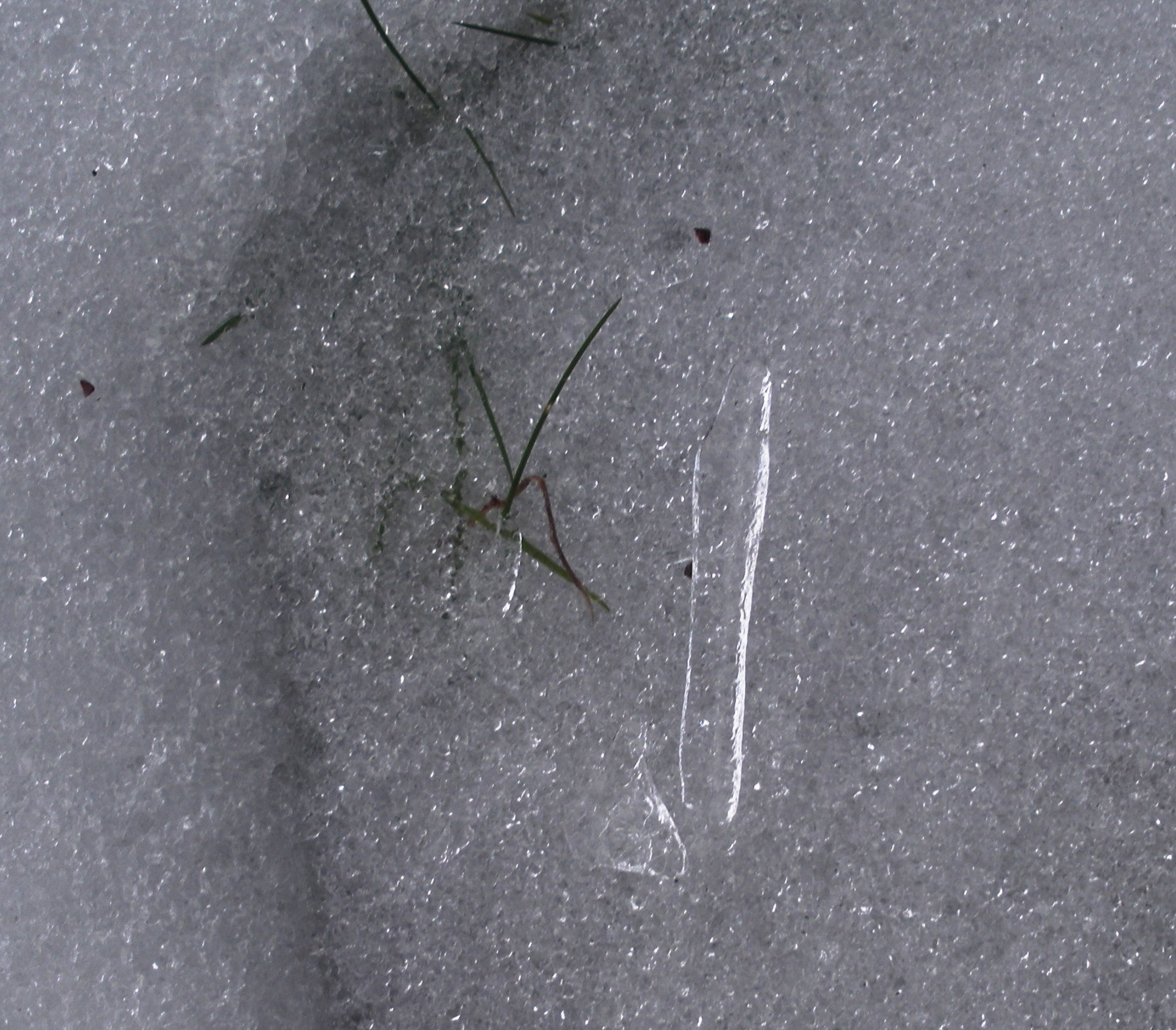 Some fierce wind kicked up a few days later, and at first I thought our windows were being pelted with hail, but after going outside later after the storm the snow was littered with ice in the shape of half pipes. That’s what happens when you live in Los Angeles all your life. People who grow up in cold climates probably know all about this stuff and have names for it, but I had no clue where the things came from.
Some fierce wind kicked up a few days later, and at first I thought our windows were being pelted with hail, but after going outside later after the storm the snow was littered with ice in the shape of half pipes. That’s what happens when you live in Los Angeles all your life. People who grow up in cold climates probably know all about this stuff and have names for it, but I had no clue where the things came from. 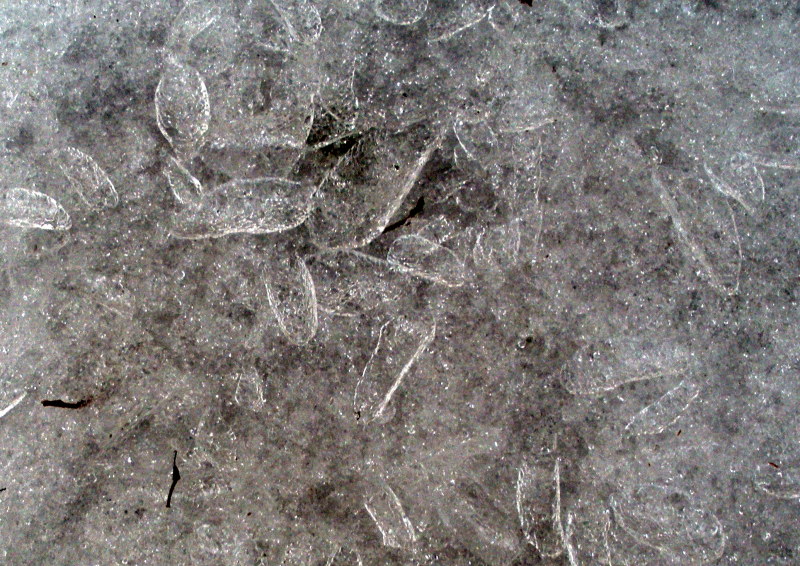 It took another large gust of wind for me to see that these were the shells of ice that formed on the branches of trees and leaves, sliding off only after the wind had bent and shaken the branches enough to liberate the half-pipes and leaf-shaped ice.
It took another large gust of wind for me to see that these were the shells of ice that formed on the branches of trees and leaves, sliding off only after the wind had bent and shaken the branches enough to liberate the half-pipes and leaf-shaped ice.
Here is another one of those little attention grabbers for you: an incredible amount of water has passed through your body, and then gone back into the atmosphere by sweat and — other means. That water gets churned around so much in the clouds that most of the water that has ever passed through you is completely mixed up by now with all the other water on the planet. So much so that, in each of those six little snowflakes I photographed above, when you do the math, on average each one of them has about a thousand molecules of water that were once inside of you.
Think about that some time. It’s deep.
If you turn the mathematics around the other way, it also means this: think about any famous person in history, Alexander the Great, Jesus, Buddha, Genghis Khan, Queen Nefertiti. According to the laws of probability, it is virtually certain that you now have within your own body, molecules of water that once coursed through the veins of each of these men and women. For millions of years, billions of humans have come and gone, leaving behind their water. And you have within you a few molecules from each of them, as well as uncounted numbers of lions, pterodactyls, and velociraptors, all life going all the way back to the beginning of the world, made from water and other elements formed by a long dead star that exploded in a supernova perhaps eight billion years ago.
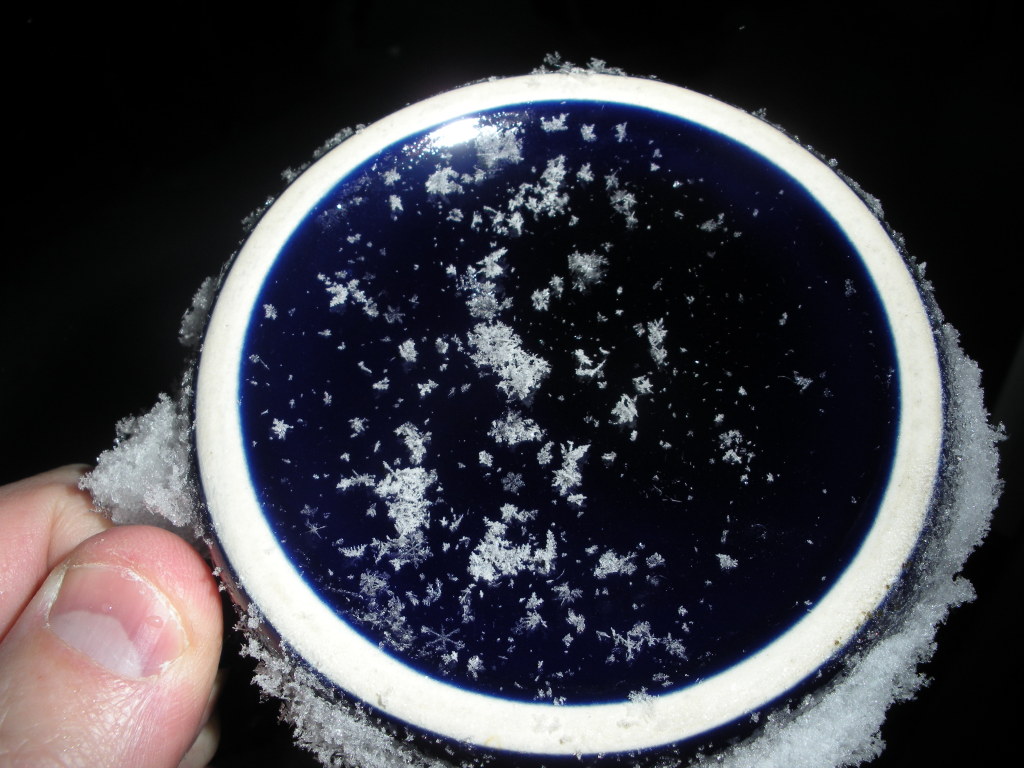 I started this little essay with a discussion of the big bang, and I leave you now with another picture of the same universe pictured before, in the coffee mug from which it came.
I started this little essay with a discussion of the big bang, and I leave you now with another picture of the same universe pictured before, in the coffee mug from which it came.
Ah, coffee. Remind me to talk about the shape of the caffeine molecule some day…
